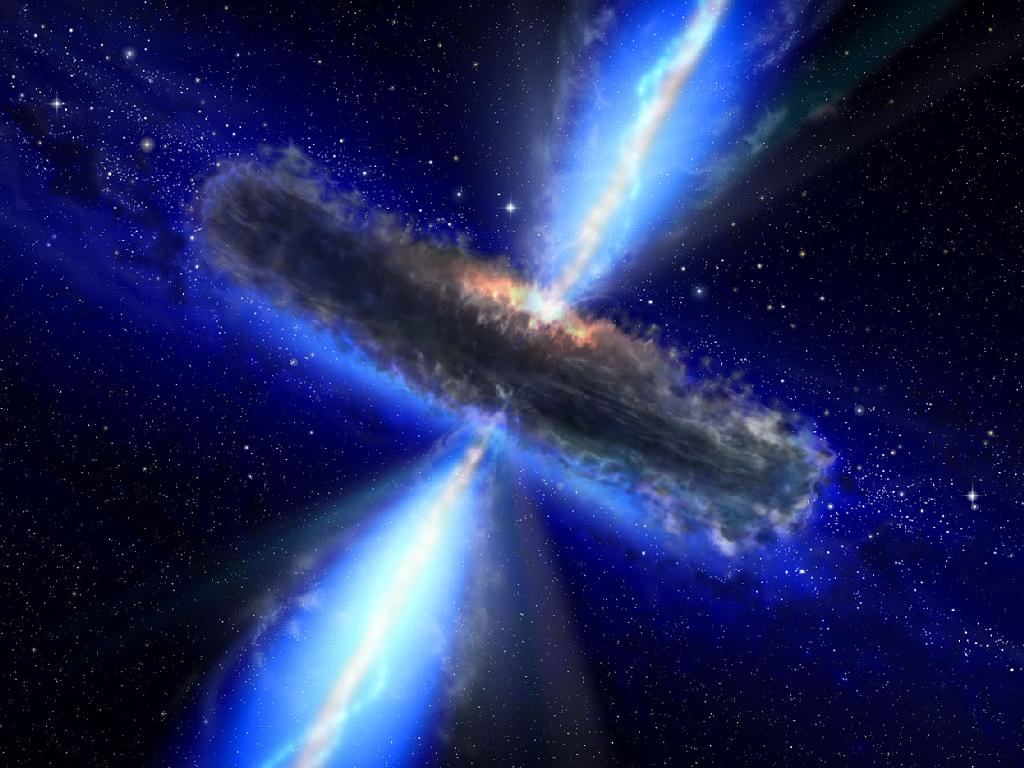Astronomers Find Largest, Oldest Mass of Water in Universe

Astronomers have discovered the largest and oldest mass of water ever detected in the universe — a gigantic, 12-billion-year-old cloud harboring 140 trillion times more water than all of Earth's oceans combined.
The cloud of water vapor surrounds a supermassive black hole called a quasar located 12 billion light-years from Earth. The discovery shows that water has been prevalent in the universe for nearly its entire existence, researchers said.
"Because the light we are seeing left this quasar more than 12 billion years ago, we are seeing water that was present only some 1.6 billion years after the beginning of the universe," said study co-author Alberto Bolatto, of the University of Maryland, in a statement. "This discovery pushes the detection of water one billion years closer to the Big Bang than any previous find."
Studying a distant quasar
Quasars are the most luminous, most powerful and most energetic objects in the universe. They are powered by enormous black holes that suck in surrounding gas and dust and spew out huge amounts of energy.
The research team studied a particular quasar called APM 08279+5255, which harbors a black hole 20 billion times more massive than the sun and produces as much energy as one quadrillion suns. [The Top 10 Strangest Things in Space]
The astronomers used two different telescopes, one in Hawaii and one in California, to detect and confirm the water vapor surrounding the quasar.
Get the Space.com Newsletter
Breaking space news, the latest updates on rocket launches, skywatching events and more!
Scientists think water vapor was present even in the early universe. So finding this old cloud of the stuff doesn't come as a shock.
"It's another demonstration that water is pervasive throughout the universe, even at the very earliest times," said study lead author Matt Bradford of NASA's Jet Propulsion Laboratory in Pasadena, Calif.
However, the sheer size of the vapor cloud may surprise some scientists. APM 08279+5255 contains 4,000 times more water vapor than our own Milky Way galaxy, researchers said. That may be because much of the Milky Way's water is locked up in ice rather than vapor.
Learning about the quasar
The water vapor in the quasar is distributed around the massive black hole in a region spanning hundreds of light-years. The cloud has a temperature of minus 63 degrees Fahrenheit (minus 53 degrees Celsius), and it's 300 trillion times less dense than Earth's atmosphere.
That may sound chilly and tenuous, but it means the cloud is five times hotter and 10 to 100 times denser than what's typical in galaxies like the Milky Way, researchers said.
In addition to shedding light on the early universe, the huge vapor cloud also reveals some important information about the quasar, researchers said.
Measurements of the water vapor and of other molecules, such as carbon monoxide, suggest that there is enough gas to feed the black hole until it grows to about six times its size. Whether or not this will happen is unclear, researchers said, since some of the gas may end up condensing into stars or may be ejected from the quasar.
The study has been accepted for publication in the Astrophysical Journal Letters.
Follow SPACE.com for the latest in space science and exploration news on Twitter @Spacedotcom and on Facebook.
Join our Space Forums to keep talking space on the latest missions, night sky and more! And if you have a news tip, correction or comment, let us know at: community@space.com.

Space.com is the premier source of space exploration, innovation and astronomy news, chronicling (and celebrating) humanity's ongoing expansion across the final frontier. Originally founded in 1999, Space.com is, and always has been, the passion of writers and editors who are space fans and also trained journalists. Our current news team consists of Editor-in-Chief Tariq Malik; Editor Hanneke Weitering, Senior Space Writer Mike Wall; Senior Writer Meghan Bartels; Senior Writer Chelsea Gohd, Senior Writer Tereza Pultarova and Staff Writer Alexander Cox, focusing on e-commerce. Senior Producer Steve Spaleta oversees our space videos, with Diana Whitcroft as our Social Media Editor.









